
- Glowing in the Gulf
- Radiation, Genetically Engineered Drugs, and
the Gulf War Syndrome
by Mitchel Cohen
 The U.S. escaped the 1991 Gulf war with few direct casualties. While
250,000 Iraqis were killed outright by the U.S. and another 750,000 died
as a result of the U.N.'s international embargo spearheaded by the U.S.,
"only" 376 U.S. soldiers died in the Gulf; almost all of them
were killed by so-called "friendly fire," shot accidentally by
their fellow soldiers.(1) The fourteen U.S. MlA1 Abrams tanks and fifteen
U.S. Bradley Fighting vehicles destroyed in the Gulf war were knocked out
by "friendly fire" as well.
The U.S. escaped the 1991 Gulf war with few direct casualties. While
250,000 Iraqis were killed outright by the U.S. and another 750,000 died
as a result of the U.N.'s international embargo spearheaded by the U.S.,
"only" 376 U.S. soldiers died in the Gulf; almost all of them
were killed by so-called "friendly fire," shot accidentally by
their fellow soldiers.(1) The fourteen U.S. MlA1 Abrams tanks and fifteen
U.S. Bradley Fighting vehicles destroyed in the Gulf war were knocked out
by "friendly fire" as well.
-
- All twenty-nine vehicles were hit by a new kind of ammunition: shells
encased in "depleted uranium" (DU), which makes them super hard
and able to penetrate all existing armor-plating. DU was used exclusively
by U.S. and British forces in the Gulf not only as armor-penetrating ammunition
by MlA1 Abrams tanks and A-10 attack planes, but as tank armor. DU, which
is 1.6 times denser than lead, proved so effective that not a single U.S.
tank was destroyed by Iraqi fire.
-
- Over the course of the two month war, 3,700 Iraqi tanks were obliterated-
1,400 of them by shells encased in depleted uranium. Thousands of artillery
pieces, armored personnel carriers and other equipment were destroyed by
DU rounds. 940,000 30mm shells encased in depleted uranium were fired from
U.S. planes, and 14,000 larger DU shells from tanks, along with an untold
number of Tomahawk missiles tipped with depleted uranium. By war's end,
roughly 300 tons of uranium from spent rounds lay scattered in various
sizes and states of decay across the battlefields of Iraq and Kuwait.(2)
Welcome to the wave of the future: '`low intensity" nuclear war, inaugurated
in the Gulf War by the United States.(3)
-
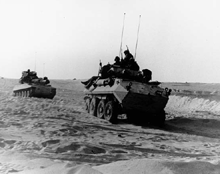 Depleted uranium1 is a highly toxic and radioactive by-product of the
uranium enrichment process used in nuclear reactors and the manufacture
of nuclear weapons. Natural uranium, with a half-life of 4.5 billion years,
is comprised of three isotopes: 99.27 percent U238, 0.72 percent U235,
and .0057 percent U234. DU is uranium with the U235 isotope-the fissionable
material-reduced from 0.7 percent to 0.2 percent-thus, "depleted."
The Pentagon says DU is relatively harmless, emitting "only"
60 percent the radiation of non-depleted uranium. But Dr. Ernest Sternglass,
Jay Gould and Benjamin Goldman have shown that even low-level radiation
emitted during the "normal" functioning of nuclear power plants
creates havoc with people's immune system as well as the surrounding environment.(4)
And, according to independent scientists, "a DU antitank round outside
its metal casing can emit as much radiation in one hour as fifty chest
X-rays."(5) A tank driver receives a radiation dose of 0.13 mrem/hr
to his or her head from overhead DU armor,(6) which may seem like a very
low dose. However, after 32 continuous days, or 64 12-hour days, the amount
of radiation a tank driver receives to his head will exceed the Nuclear
Regulatory Commission's standard for public whole-body annual exposure
to man-made sources of radiation.(7) Unfortunately, U.S. tank crews were
not monitored for radiation exposure during the Gulf war.(8)
Depleted uranium1 is a highly toxic and radioactive by-product of the
uranium enrichment process used in nuclear reactors and the manufacture
of nuclear weapons. Natural uranium, with a half-life of 4.5 billion years,
is comprised of three isotopes: 99.27 percent U238, 0.72 percent U235,
and .0057 percent U234. DU is uranium with the U235 isotope-the fissionable
material-reduced from 0.7 percent to 0.2 percent-thus, "depleted."
The Pentagon says DU is relatively harmless, emitting "only"
60 percent the radiation of non-depleted uranium. But Dr. Ernest Sternglass,
Jay Gould and Benjamin Goldman have shown that even low-level radiation
emitted during the "normal" functioning of nuclear power plants
creates havoc with people's immune system as well as the surrounding environment.(4)
And, according to independent scientists, "a DU antitank round outside
its metal casing can emit as much radiation in one hour as fifty chest
X-rays."(5) A tank driver receives a radiation dose of 0.13 mrem/hr
to his or her head from overhead DU armor,(6) which may seem like a very
low dose. However, after 32 continuous days, or 64 12-hour days, the amount
of radiation a tank driver receives to his head will exceed the Nuclear
Regulatory Commission's standard for public whole-body annual exposure
to man-made sources of radiation.(7) Unfortunately, U.S. tank crews were
not monitored for radiation exposure during the Gulf war.(8)
-
- When properly encased, the Pentagon says DU gives off very little radiation.
But DU becomes much more radioactive when it burns. When fired it combusts
on impact. "As much as 70 percent of the material is released as a
radioactive and highly toxic dust that can be inhaled or ingested and then
trapped in the lungs or kidneys."(9) One researcher found that a single
molecular particle of depleted uranium will subject an individual to radiation
at a level 800 times what is permitted by federal regulations for external
exposure.(10) Twenty-two vets still have uranium shrapnel imbedded in their
bodies. As DU-artillery shells heat up, the uranium becomes aerosolized,
releasing high amounts of radioactivity -not the low amounts the military
claims for "normal" depleted uranium. Clouds of deadly uranium
dioxide dust particles swept over large areas of Iraq and Kuwait, devastating
agriculture, soil and water.(11)
-
- One army reserve engineer said he was relieved when he found out that
a deafening explosion near his unit's camp just inside the Kuwaiti border
was not an Iraqi chemical or nuclear attack, but the accidental explosion
of a 40ton U.S. Hemmt transport vehicle carrying DU antitank rounds. "It
was about 1,000 meters from our camp and the wind was blowing our way,"
he said. "A big black cloud blew right over us."(12) In a survey
of 10,051 Gulf War vets, it has been found that 82 percent had entered
captured Iraqi vehicles, many of which were disabled by DU rounds. With
more than 600,000 pounds of depleted uranium left scattered throughout
the region, by war's end the U.S. had turned the Gulf area into a deadly
radioactive grid, affecting not only U.S. soldiers but hundreds of thousands,
perhaps millions, of people who live in the Gulf. Is it any wonder that
many symptoms of
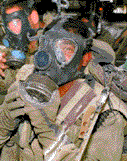 Gulf War Syndrome are so similar to radiation
sickness?
Gulf War Syndrome are so similar to radiation
sickness?
-
- Radioactivity inflicts severe damage on the total environment while
weakening immune systems, destroying the kidneys, lungs, bones and liver,
and rendering the human body susceptible to all sorts of diseases a healthy
individual is able to ward off. Iraqi children continue to find uranium-coated
shells; they have been coming down with all sorts of deadly illnesses associated
with radiation poisoning. A secret report by the British government estimated
that the use of depleted uranium weapons in the Gulf could alone account
for 500,000 deaths in the region.(13) That report was based on estimates
that 25 tons of depleted uranium munitions had been used; in actuality,
the Department of Defense now estimates that the U.S. fired more than 12
times that amount.
-
- As the only country to have ever dropped atomic bombs on a populated
area, the U.S. government has long attempted to circumvent international
treaties and develop ever-newer weapons of mass destruction. In 1953, Gen.
Douglas McArthur issued a plan to dump radioactive cobalt across Korea
to create a permanent radioactive barrier between the North and South.
That plan was considered but never implemented (as far as we know). President
Jimmy Carter tried to obtain funding for a "neutron bomb" that
would annihilate people and all living beings but leave buildings and capital
intact. That project was beaten back by public outcry and mass protests.
The U.S. government has threatened to use nuclear weapons on dozens of
occasions, including against Vietnam in 1953 and again in 1969-the latter
squelched at the last minute by President Richard Nixon due to the huge
anti-war protests taking place at the time in the U.S.(14) In fact, so
adamently has the world's population-including the vast majority in the
U.S.-opposed atomic weapons of every sort that it took the enormous propaganda
effort of the Gulf War for the U.S. government, for the first time since
Hiroshima and Nagasaki, to get away with using radioactive weapons against
living people.
-
- The U.S. Department of Defense has more than 1.1 billion pounds of
nuclear waste in storage from fifty years of nuclear weapons production
and nuclear power plants. The government, hemmed in by public opposition,
health and environmental movements, is always trying to find new "acceptable"
ways to dispose of it. It has apparently found one. Billions of dollars
allotted to the Environmental Restoration branch of the Department of Energy
for cleaning up nuclear waste sites is now being used instead to ship nuclear
waste free of charge to munitions manufacturers all over the world to be
"recycled" into weapons.
-
- Dr. Helen Caldicott reports that these radiological weapons have already
been exported to Taiwan, Thailand, Korea, Bahrain, Israel, Saudi Arabia,
Greece, Turkey, Kuwait and others. Where is the cry at the United Nations
to end the manufacture, distribution and use of such weapons before it's
too late? In introducing the use of depleted uranium weapons the U.S. government
used its own soldiers as guinea pigs,permanently destroyed the ecology
of the region, and left an ongoing legacy of childhood leukemia, birth
defects and poisoned water for civilians living in the Gulf. And the U.S.-as
it did in dropping atomic bombs on Hiroshima and Nagasaki-has made tile
horror of low intensity nuclear weapons the necessary norm for future conflicts.
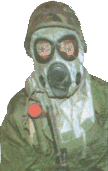
-
- For years, the U.S. government has denied that Gulf War Syndrome exists,
let alone admit to the severity of illnesses suffered by tens of thousands
of Gulf War veterans.(15) New studies, however, show that the soldiers'
illnesses are indeed real, and that troops deployed to the Gulf were more
than three times as likely as U.S. soldiers elsewhere to suffer chronic
diarrhea, joint pain, skin rashes, fatigue, depression, and memory loss.(16)
-
- Many veterans also suffer shooting pains during sexual intercourse,
severe nausea, chest pains, general weakness, wasting disease, burning
semen (reported by male veterans and their sexual partners), blistering,
swelling, chronic fatigue, and serious birth defects and illnesses (leukemia,
cancers) in their children.(17) Unfortunately, many vets are buying the
U.S. government's new line: that these illnesses-Gulf War Syndrome- were
caused by exposure to Iraqi nerve gas.
-
- As it turned out, however, Iraq never actually used nerve gas during
the war. So, it's time for the U.S. government's fall back position: Perhaps
the U.S. military accidentally blew up Iraqi nerve gas canisters when it
bombed various sites. By accident? With our fabled "smart bombs,"
originally reported to hit 93 percent of their targets with pinpoint accuracy?
Those dastardly Iraqis, placing deadly nerve gas canisters beneath "our"
missiles! As the poet Diane DiPrima remarked: "Get your cut throat
off my knife!"
-
- It was not until late 1996 that the Pentagon acknowledged "that
more than 20,000 American troops may have been exposed to low doses of
the nerve gas sarin after the demolition of an Iraqi ammunition depot in
March 1991,(18) after the official end of the war. At the same time, a
special White House panel condemned the Pentagon for its shoddy investigation
into the more than fifteen incidents in which nerve gas and other chemical
agents were detected by American troops, and, according to a New York Times
report, for "conducting a superficial investigation ... of American
soldiers' [claims] that they were exposed to clouds of Iraqi chemical or
biological weapons in the war."(19)
-
- Earlier this year, a group of scientists at the University of Texas
reported that "exposure to combinations of chemicals, including pesticides
and low levels of nerve gas, were probably responsible for the health problems
of gulf war veterans,"(20) an assertion immediately questioned by
the Pentagon and by other researchers.
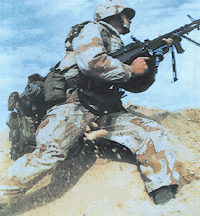
- The British government, on the other hand, now clearly states that
"OPs"-derived from a class of compounds known as organophosphates,
the chief ingredients in many pesticides and herbicides, in addition to
nerve gas-were the cause of Gulf War Syndrome among its soldiers. Still,
the numbers don't add up; "only" 20,000 troops, hardly enough
to account for the huge numbers of complaints from Gulf veterans-no U.S./U.N.
officials or media even bother to assess the effects on Iraq's population-were
exposed to the sole acknowledged U.S. destruction of an Iraqi weapons storage
facility, the one at Kamisiyah, on March 4 and 10, 1991 (with possibly
another explosion on March 12).
-
- Not only are there "several mysterious gaps" in the military's
"otherwise meticulous combat logs" for the dates on which the
Army's 37th Engineer Battalion blew up the depot,(21) but the U.S. military
command, including Generals Colin Powell and Norman Schwarzkopf, refused
to order the use of protective gear for soldiers in the area, claiming
such an order would spread panic through the ranks.(22) Schwarzkopf, commander
of U.S. Gulf War forces, denies U.S. troops were exposed to biological
or chemical weapons.(23)
-
- With the White House panel dismissing claims of the 24th Naval Mobile
Construction Battalion and other units concerning their positive readings
for mustard gas,(24) stating that "the evidence does not show that
chemicals wafted over most of the soldiers who are now reporting ailments"
and that "theater-wide contamination is highly unlikely,"(25)
this fall back position as well is beginning to unravel.
-
- There appears to be a long history of using U.S. servicemen as guinea
pigs. In 1969 President Nixon issued an Executive Order banning biological
weapons, saying: "Biological weapons have massive, unpredictable,
and potentially uncontrollable consequences. They may produce global epidemics
and impair the health of future generations"?(31)
-
- Despite the ban, in January 1977 UPI reported a soldier had been accidentally
exposed to the
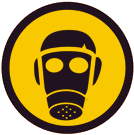 hallucinogenic agent BZ at the Dugway Proving Grounds,
and hospitalized with hallucinations and rapid heartbeat. He became exposed
while he and another soldier were opening cluster bombs containing the
BZ.(32) The press concerned itself only with the danger of the gas leaking
out.
hallucinogenic agent BZ at the Dugway Proving Grounds,
and hospitalized with hallucinations and rapid heartbeat. He became exposed
while he and another soldier were opening cluster bombs containing the
BZ.(32) The press concerned itself only with the danger of the gas leaking
out.
-
- Who authorized the production of cluster bombs containing hallucinogenic
agents, against the provisions of the Geneva Convention, to which the United
States is a signatory? That such weapons still are being manufactured and
sold despite presidential edicts and international treaties seems to have
eluded the guardians of official morality and never apparently became fit
to print.
-
- In 1981, I interviewed soldiers in the U.S. Army Reserve who told of
being "volunteered" for special duty. "Dozens of soldiers
from my Long Island unit," one soldier told me, "were exposed
to various hallucinogens in a gas form. We tried on and tested different
types of gas masks. Lots of people got sick."(33) This soldier went
on to serve in the Gulf. He now suffers from Gulf War Syndrome himself,
and is a leading critic of U.S. government duplicity on this matter.
-
- Those interviews took place 16 years ago. Have things improved? According
to one news report, in November 1991 a "tiny amount" of deadly
VX nerve agent leaked from a storage tank at an army ammunition plant outside
of Indianapolis, Indiana. One-fiftieth of a standard drop of the agent-approximately
the volume of the tip of a sharpened pencil-leaked from a faulty valve.
A single drop could kill a person in three to ten minutes.(34) The question
lingers: Why are neurotoxins continuing to be manufactured? And why were
they sold to Iraq?
-
- To understand Gulf War Syndrome and to make sense of the missing military
logs, lies within lies, we have to turn elsewhere-to the chemicals and
drugs used by the U.S. itself. U.S. soldiers during the Gulf War, as they
have been throughout history, were involuntary victims of a massive government
big-chemical warfare experiment, even as they, in turn, were carrying out
U.S. policy and slaughtering hundreds of thousands of Iraqis.

-
- Weapons Specialist Patricia Axelrod, who served in the Gulf, testified:
"The U.S. had a perfect proving ground, a perfect enemy and a perfect
living laboratory for testing new vaccines that we need for our own biological
weapons industry. It's part of the Department of Defense's scheme to relinquish
responsibility."(35) Indeed, more than onehundred thousand Gulf War
veterans have reported horrible symptoms stemming from their stint in the
Gulf.
-
- Thus far officials have ignored the probability that the illnesses
were caused by forced inoculations with experimental and genetically-engineered
drugs interacting with radiation emitted from "depleted" uranium
coated artillery shells and tank armor-itself a serious violation of the
Geneva Conventions. The government refuses to test Gulf veterans for radiation
exposure, claiming that "without forethought and data, the financial
implications of long-term disability payments and health-care costs would
be excessive. "(36)
-
- The Food and Drug Administration had given the Pentagon permission
to administer experimental drugs to U.S. troops in Saudi Arabia without
first obtaining their consent. "This is the first time since World
War II that any government in the world has said that it would give experimental
drugs to competent adults without consent," said George Annas, director
of the Health, Law and Ethics program at the Boston University Schools
of Law and Public Health.(37) Well, not quite. While making a valid point,
Annas unfortunately fails to mention the many instances of government experimentation
on unsuspecting people-the smallpox-ridden blankets given to American Indians;
the Tuskegee syphilis experiments on southern Black male prisoners; sensory
deprivation units for political prisoners at Florence, Colorado, Marion,
Illinois and Lexington, Kentucky; the testing of Hepatitis vaccines on
American Indians; the Edmonston-Zagreb, or E-Z measles vaccine, tested
in Senegal, Guinea-Bissau, Haiti, Guinea, and more than a dozen other Third
World countries as well as West and East Los Angeles and Inglewood; the
testing of birth control pills on Puerto Rican and Haitian women by the
G.D. Searle pharmaceutical company in 1956; and the forcible injections
of Haitian women imprisoned by the U.S. at its naval base at Guantanamo
Bay with Depo Provera, an experimental drug with dangerous side effects.
At the time, Depo Provera had not been approved for use in the U.S. Tracking
studies show Haitian women living in the U.S. have a much higher rate of
cervical cancer than other women in the general population; some speculate
that Depo Provera might be part of the cause. These are just a few examples
Annas, like most Americans, leaves out.
-
- One of the drugs administered to U.S. soldiers in the Gulf was atropine
sulfate. The GIs were told that the drug would save them from Iraqi nerve
gas. Not true. Although it may help ease some symptoms, atropine certainly
doesn't prevent nerve damage and is not a 'cure'. Nor were they told that
exposure to atropine in a hot environment significantly increases a person's
risk of heat stroke and could lead to serious illness. One wonders how
that impacts people wearing chemical suits in the desert, and what the
long-term side-effects will be.(38)
-
- Other drugs were administered to the soldiers without their consent.
A number of soldiers report being "held down" while being injected
against their will. The government has thus far refused to release all
the details, claiming that wartime stress, and, as a fall back position,
inadvertent exposure to chemical weapons, _not_ inoculations or radiation,
was the major factor in most of the ailments. But Dr. Katherine Murray
Leisure, an infectious disease specialist at the Veterans Affairs Medical
Center in Lebanon, Pennsylvania, counters that position.
-
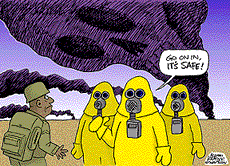 "There was an outpouring in late 1991 and 1992 of Gulf war veterans
with the exact same constellation of complaints-intestinal, bone and joint,
skin lesions-without having spoken to each other,', she said. Dr. Leisure
said it was clear to her that battlefield stress had little to do with
the vets' ailments. Stress, she said, "is an easy diagnosis that puts
the onus on the patient." She said that if her patients were now suffering
from stress, it was the stress brought on from "having doctors say
that there's nothing wrong with you when there obviously is something wrong."(39)
"There was an outpouring in late 1991 and 1992 of Gulf war veterans
with the exact same constellation of complaints-intestinal, bone and joint,
skin lesions-without having spoken to each other,', she said. Dr. Leisure
said it was clear to her that battlefield stress had little to do with
the vets' ailments. Stress, she said, "is an easy diagnosis that puts
the onus on the patient." She said that if her patients were now suffering
from stress, it was the stress brought on from "having doctors say
that there's nothing wrong with you when there obviously is something wrong."(39)
-
- The soldiers themselves have been able to fill in some of the gaps.
They speak of being forced to take "alternative malaria pills,"
and an anti-nerve gas medication called pyridostigmine bromide, sometimes
against their will and almost always without their consent.
-
- In a path breaking story in "The Nation", investigative journalist
Laura Flanders reported that according to Dr. Barry Wilson, a pharmaceutical
scientist at Battelle Pacific Northwest Laboratories in Washington, pyridostigmine
bromide "initially stimulates muscular strength and activity but eventually
decreases nerve action, possibly resulting in paralysis. Side effects are
known to include watering of the eyes, diarrhea and the urge to urinate,
as well as allergic reactions from skin rashes to loss of hair and muscle
control."(40) The Department of Defense decided to use this drug even
though research with mice indicated that the drug does not protect but
rather works with the nerve agent Sarin to cause greater damage.(41)
-
- Under FDA regulations, pyridostigmine must be administered with careful
monitoring, but the agency gave the Pentagon a waiver to use the drug randomly
in the Gulf. As a result, the 697,000 U.S. troops who served in the Gulf
from August 1990 to March 1991 were ordered not to give blood when they
returned to the U.S., although the government claimed the ban was solely
to prevent the spread of leishmaniasis, a potentially deadly blood disease
caused by parasites and spread by desert sand-flies. For more than a year
blood banks refused to accept blood from Gulf war veterans, despite severe
blood shortages.
-
- Take the case of Sgt. Carol Picou, who was an active-duty Army nurse
for fifteen years before going to the Gulf with the 41st Combat Hospital.
As Flanders reports, Picou was part of a group that came upon an area pummeled
by U.S. artillery. Scrap metal and the still-smoldering bodies of animals
and humans covered the ground. "I've seen burnt bodies," said
Picou. "And they were nothing like that. These were charred black.
It wasn't normal." They were victims of the U.S.'s new depleted uranium
weapons. Picou and her group set up camp just two miles down the road from
the contaminated battlefield, near the populous Iraqi town of Basra.
-
- "After several weeks," Flanders says, "Picou's urinary
control had gone. She couldn't keep food down and she was passing black,
tarry stools that Army doctors attributed to `'drinking too much water"
and the change in diet." Picou had been taking the pyridostigmine
bromide pills the military demanded she consume. She had also been injected
with two special vaccinations: pentavalent botulinum-toxoid, an unproven
drug used to combat botulism, and an anti-anthrax vaccine that can come
in various forms, one of which involves a live, recombinant DNA process
that is highly experimental and unlicensed.
-
- "Soon after taking the bromide, I couldn't control my eyes, nose
and facial muscles. I was overtaken with chronic sneezing, a running nose
and deltoid twitching." She tried skipping the pills to regain control
over her sight, but her local health officer demanded that she resume taking
them: 90 milligrams a day for fifteen days. "Now Carol Pichou is on
70 percent disability retirement from the
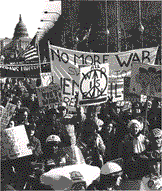 Army. Her doctor has diagnosed
depleted blood supplies reaching her left thalamus gland and neurological
damage to the left side of her brain affecting her memory, vision and speech.
She's racked with respiratory problems, abdominal distention, a rash on
her face and neck, and regular fevers. Unable to control either bowel or
bladder movements, she is forced to catheterize herself to urinate and
to wear diapers. She also wears a permanent sanitary pad-her period comes
in semimonthly cycles, one week black and tarry, the next week clotted
and profuse."(42)
Army. Her doctor has diagnosed
depleted blood supplies reaching her left thalamus gland and neurological
damage to the left side of her brain affecting her memory, vision and speech.
She's racked with respiratory problems, abdominal distention, a rash on
her face and neck, and regular fevers. Unable to control either bowel or
bladder movements, she is forced to catheterize herself to urinate and
to wear diapers. She also wears a permanent sanitary pad-her period comes
in semimonthly cycles, one week black and tarry, the next week clotted
and profuse."(42)
-
- Gen. Schwarzkopf himself said that when he first heard that the veterans
were falling ill, he believed it was a reaction to the drugs.(43) But he
apparently was persuaded by government and pharmaceutical company officials
who shuttled the blame (when they admitted Gulf War Syndrome existed at
all) onto "stress" and leishmaniasis.
-
- But the government story is damned by its own documents. A Pentagon
flyer circulated to Gulf veterans, "Briefing for Soldiers Returned
from S.W.A. [Southwest Asia]-Leishmaniasis," claimed that the disease
is "not dangerous to your health and a normal healthy body will control
the infection without medical attention."(44) So then why worry about
blood donations? Clearly, more than leishmaniasis-dangerous though it may
be, for some-was prompting concern. What could weaken the immune system
enough to make deadly a disease that "a normal healthy body will control"?
Clearly, the widespread administration of experimental, genetically engineered
drugs, the "frequent and massive aerial 'bombings' (sprayings)"
of OP-based pesticides and insect repellents on troop areas, saturating
clothing and tents, and the proximity to radiation emitted from depleted
uranium all combined to attack the immune system.(45) Of the countries
involved in the Gulf War, only France, whose military officials refused
to order their troops to take pyridostigmine bromide or the other vaccines,
has seen little or no evidence of veterans suffering from Gulf War Syndrome.(46)
-
- The role of the pharmaceutical companies is as odious as that of the
government and military. One only has to look at Monsanto's testing, manufacturing
and marketing of Agent Orange, to reveal the web of lies and collaboration
between industry and government. Back in the 1960s, Monsanto, working closely
with the Pentagon and the Veterans' Administration, intentionally falsified
key data on the effects of Agent Orange on human health in order to sell
the deadly defoliant to the government for "use" in Vietnam.(47)
Admiral Elmo Zumwalt, commander of U.S. naval forces in Vietnam and member
of the Joint Chiefs of Staff, charged that the government's exoneration
of Agent Orange was "politically motivated ... to cover up the true
effects of dioxin, and manipulate public perception [and] coincide with
similar, economically motivated, efforts of chemical companies that produce
dioxin."(48) Today, Monsanto, Hoffman-LaRoche and other manufacturers
of the vaccines given to GIs, are working "behind the scenes to contain
the government investigation of Gulf veterans' health problems."(49)
They are engaging in an enormous cover-up of genetically-engineered drugs,
herbicides and pesticides, and uranium weaponry-a cover-up essential in
insuring mega-profits, business as usual.
-
 The U.S. used its own soldiers-who, for the first time, included far
more Blacks and Latinos than ever before, which is not an incidental circumstance
[see Sidebar: Racially-Targeted Bio Warfare]-as guinea pigs. It is likely
that depleted uranium weapons and military-administered inoculants, some
genetically-engineered, combined to cause what we now call Gulf War Syndrome.
Clearly the horrors the U.S. military inflicted on the people of Iraq are
returning as avenging specters. The slaughter that imperial militaries
inflict on other people always, one way or another, comes back to haunt
the perpetrator. The human cost to the U.S. of its venture in the Gulf
increases daily, as new U.S. casualties are discovered-cancers, birth defects,
tumors, broken lives.
The U.S. used its own soldiers-who, for the first time, included far
more Blacks and Latinos than ever before, which is not an incidental circumstance
[see Sidebar: Racially-Targeted Bio Warfare]-as guinea pigs. It is likely
that depleted uranium weapons and military-administered inoculants, some
genetically-engineered, combined to cause what we now call Gulf War Syndrome.
Clearly the horrors the U.S. military inflicted on the people of Iraq are
returning as avenging specters. The slaughter that imperial militaries
inflict on other people always, one way or another, comes back to haunt
the perpetrator. The human cost to the U.S. of its venture in the Gulf
increases daily, as new U.S. casualties are discovered-cancers, birth defects,
tumors, broken lives.
-
-
-
- notes and author bio
-
- other resources:
-
- Frontline
- National Gulf War
Resource Center
 The U.S. escaped the 1991 Gulf war with few direct casualties. While
250,000 Iraqis were killed outright by the U.S. and another 750,000 died
as a result of the U.N.'s international embargo spearheaded by the U.S.,
"only" 376 U.S. soldiers died in the Gulf; almost all of them
were killed by so-called "friendly fire," shot accidentally by
their fellow soldiers.(1) The fourteen U.S. MlA1 Abrams tanks and fifteen
U.S. Bradley Fighting vehicles destroyed in the Gulf war were knocked out
by "friendly fire" as well.
The U.S. escaped the 1991 Gulf war with few direct casualties. While
250,000 Iraqis were killed outright by the U.S. and another 750,000 died
as a result of the U.N.'s international embargo spearheaded by the U.S.,
"only" 376 U.S. soldiers died in the Gulf; almost all of them
were killed by so-called "friendly fire," shot accidentally by
their fellow soldiers.(1) The fourteen U.S. MlA1 Abrams tanks and fifteen
U.S. Bradley Fighting vehicles destroyed in the Gulf war were knocked out
by "friendly fire" as well.
 Depleted uranium1 is a highly toxic and radioactive by-product of the
uranium enrichment process used in nuclear reactors and the manufacture
of nuclear weapons. Natural uranium, with a half-life of 4.5 billion years,
is comprised of three isotopes: 99.27 percent U238, 0.72 percent U235,
and .0057 percent U234. DU is uranium with the U235 isotope-the fissionable
material-reduced from 0.7 percent to 0.2 percent-thus, "depleted."
The Pentagon says DU is relatively harmless, emitting "only"
60 percent the radiation of non-depleted uranium. But Dr. Ernest Sternglass,
Jay Gould and Benjamin Goldman have shown that even low-level radiation
emitted during the "normal" functioning of nuclear power plants
creates havoc with people's immune system as well as the surrounding environment.(4)
And, according to independent scientists, "a DU antitank round outside
its metal casing can emit as much radiation in one hour as fifty chest
X-rays."(5) A tank driver receives a radiation dose of 0.13 mrem/hr
to his or her head from overhead DU armor,(6) which may seem like a very
low dose. However, after 32 continuous days, or 64 12-hour days, the amount
of radiation a tank driver receives to his head will exceed the Nuclear
Regulatory Commission's standard for public whole-body annual exposure
to man-made sources of radiation.(7) Unfortunately, U.S. tank crews were
not monitored for radiation exposure during the Gulf war.(8)
Depleted uranium1 is a highly toxic and radioactive by-product of the
uranium enrichment process used in nuclear reactors and the manufacture
of nuclear weapons. Natural uranium, with a half-life of 4.5 billion years,
is comprised of three isotopes: 99.27 percent U238, 0.72 percent U235,
and .0057 percent U234. DU is uranium with the U235 isotope-the fissionable
material-reduced from 0.7 percent to 0.2 percent-thus, "depleted."
The Pentagon says DU is relatively harmless, emitting "only"
60 percent the radiation of non-depleted uranium. But Dr. Ernest Sternglass,
Jay Gould and Benjamin Goldman have shown that even low-level radiation
emitted during the "normal" functioning of nuclear power plants
creates havoc with people's immune system as well as the surrounding environment.(4)
And, according to independent scientists, "a DU antitank round outside
its metal casing can emit as much radiation in one hour as fifty chest
X-rays."(5) A tank driver receives a radiation dose of 0.13 mrem/hr
to his or her head from overhead DU armor,(6) which may seem like a very
low dose. However, after 32 continuous days, or 64 12-hour days, the amount
of radiation a tank driver receives to his head will exceed the Nuclear
Regulatory Commission's standard for public whole-body annual exposure
to man-made sources of radiation.(7) Unfortunately, U.S. tank crews were
not monitored for radiation exposure during the Gulf war.(8)
 Gulf War Syndrome are so similar to radiation
sickness?
Gulf War Syndrome are so similar to radiation
sickness?



 "There was an outpouring in late 1991 and 1992 of Gulf war veterans
with the exact same constellation of complaints-intestinal, bone and joint,
skin lesions-without having spoken to each other,', she said. Dr. Leisure
said it was clear to her that battlefield stress had little to do with
the vets' ailments. Stress, she said, "is an easy diagnosis that puts
the onus on the patient." She said that if her patients were now suffering
from stress, it was the stress brought on from "having doctors say
that there's nothing wrong with you when there obviously is something wrong."(39)
"There was an outpouring in late 1991 and 1992 of Gulf war veterans
with the exact same constellation of complaints-intestinal, bone and joint,
skin lesions-without having spoken to each other,', she said. Dr. Leisure
said it was clear to her that battlefield stress had little to do with
the vets' ailments. Stress, she said, "is an easy diagnosis that puts
the onus on the patient." She said that if her patients were now suffering
from stress, it was the stress brought on from "having doctors say
that there's nothing wrong with you when there obviously is something wrong."(39)
 Army. Her doctor has diagnosed
depleted blood supplies reaching her left thalamus gland and neurological
damage to the left side of her brain affecting her memory, vision and speech.
She's racked with respiratory problems, abdominal distention, a rash on
her face and neck, and regular fevers. Unable to control either bowel or
bladder movements, she is forced to catheterize herself to urinate and
to wear diapers. She also wears a permanent sanitary pad-her period comes
in semimonthly cycles, one week black and tarry, the next week clotted
and profuse."(42)
Army. Her doctor has diagnosed
depleted blood supplies reaching her left thalamus gland and neurological
damage to the left side of her brain affecting her memory, vision and speech.
She's racked with respiratory problems, abdominal distention, a rash on
her face and neck, and regular fevers. Unable to control either bowel or
bladder movements, she is forced to catheterize herself to urinate and
to wear diapers. She also wears a permanent sanitary pad-her period comes
in semimonthly cycles, one week black and tarry, the next week clotted
and profuse."(42)
 The U.S. used its own soldiers-who, for the first time, included far
more Blacks and Latinos than ever before, which is not an incidental circumstance
[see Sidebar: Racially-Targeted Bio Warfare]-as guinea pigs. It is likely
that depleted uranium weapons and military-administered inoculants, some
genetically-engineered, combined to cause what we now call Gulf War Syndrome.
Clearly the horrors the U.S. military inflicted on the people of Iraq are
returning as avenging specters. The slaughter that imperial militaries
inflict on other people always, one way or another, comes back to haunt
the perpetrator. The human cost to the U.S. of its venture in the Gulf
increases daily, as new U.S. casualties are discovered-cancers, birth defects,
tumors, broken lives.
The U.S. used its own soldiers-who, for the first time, included far
more Blacks and Latinos than ever before, which is not an incidental circumstance
[see Sidebar: Racially-Targeted Bio Warfare]-as guinea pigs. It is likely
that depleted uranium weapons and military-administered inoculants, some
genetically-engineered, combined to cause what we now call Gulf War Syndrome.
Clearly the horrors the U.S. military inflicted on the people of Iraq are
returning as avenging specters. The slaughter that imperial militaries
inflict on other people always, one way or another, comes back to haunt
the perpetrator. The human cost to the U.S. of its venture in the Gulf
increases daily, as new U.S. casualties are discovered-cancers, birth defects,
tumors, broken lives.